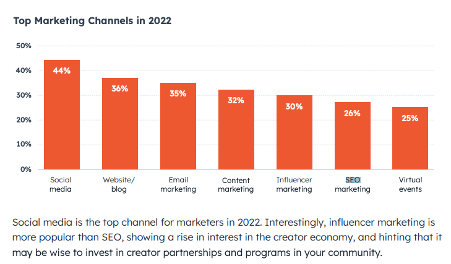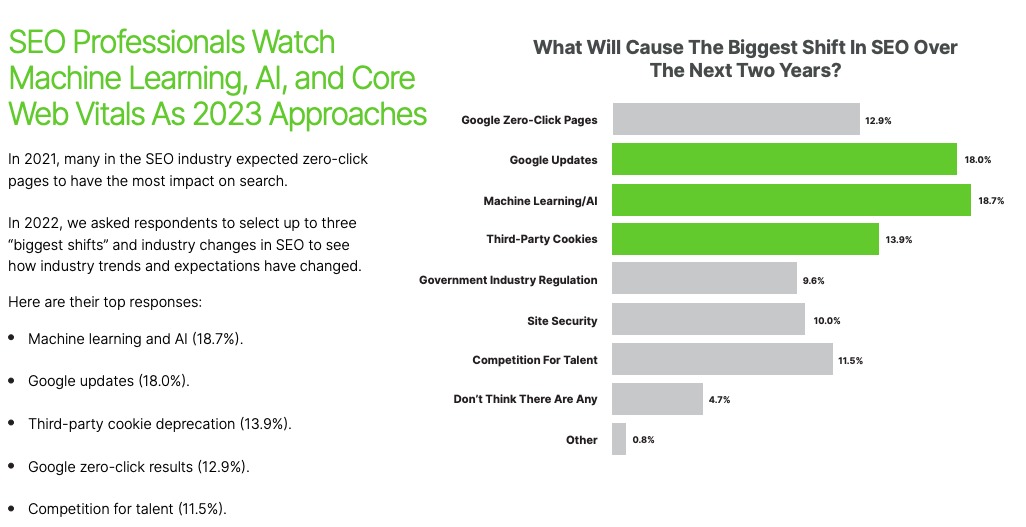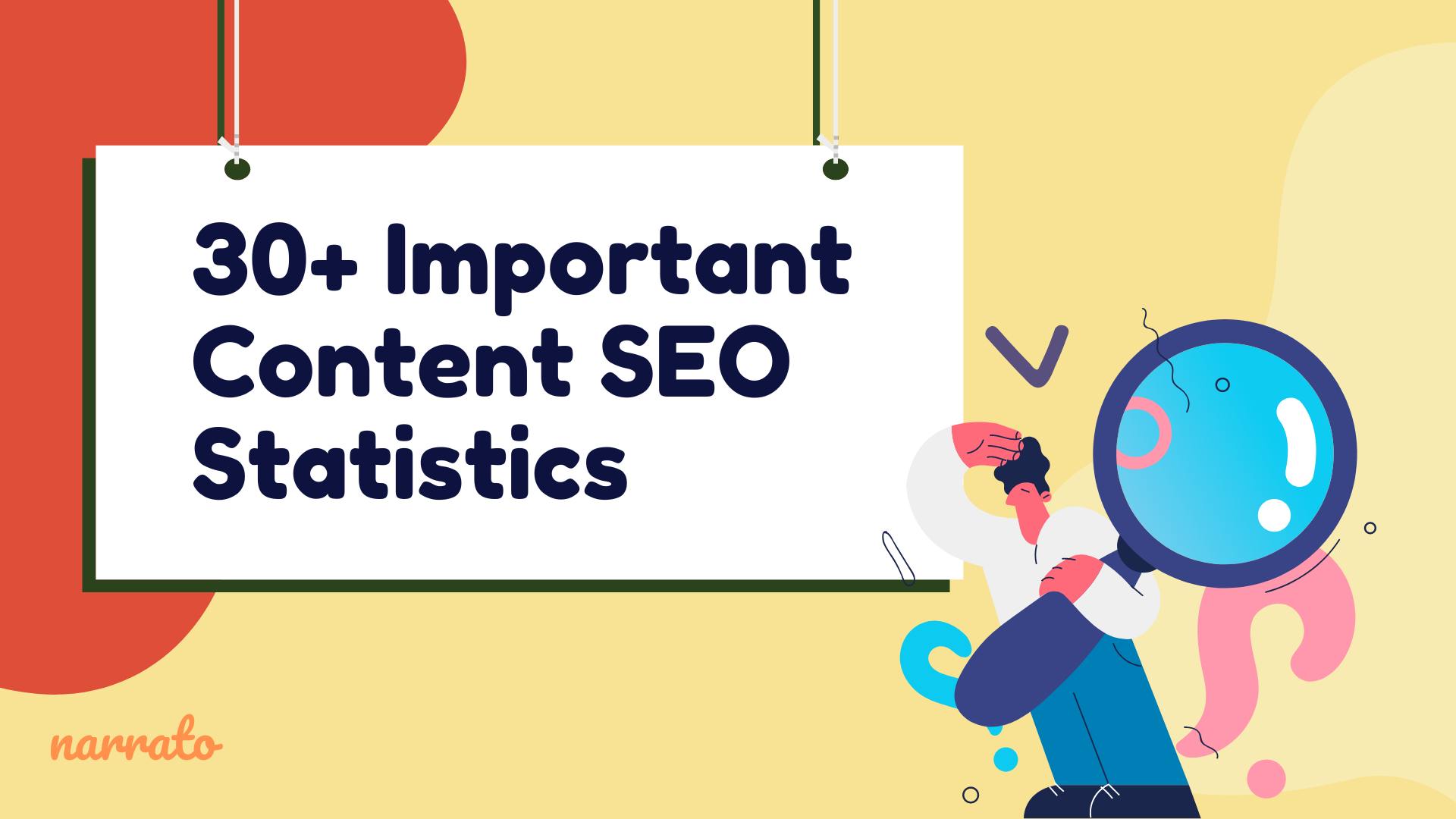If you’re a content marketer, you know firsthand how crucial SEO is to your success. To ensure the visibility of your content on the SERPs, you might be thoughtfully choosing your content title and headers, generating SEO content briefs, sprinkling in keywords throughout the article, and adding the meta data. And even then, sometimes it feels like you’re shooting in the dark. Where should you put your keywords? How do you make sure your headline and first paragraph are well-optimized? Is there anything else you can do with your content to climb your way to the top of the SERPs? Maybe the answer to all these questions can be found through some useful content SEO statistics. By learning how other marketers are leveraging SEO.
Keeping up with the latest SEO trends in the world of content creation is the need of the hour. So we’re here to make this a little easier for you, helping you build a solid content SEO strategy. In the following sections, we’ll provide you with the latest content SEO statistics that can help guide and inform your content creation and marketing strategy in 2023.
Content SEO Statistics Every Content Marketer Must Know
- Content SEO Statistics – Content SEO Strategy
- Content SEO Statistics – Top Trends
- Content SEO Statistics – Local SEO
- Content SEO Statistics – Content SEO Challenges
- Content SEO Statistics – SEO Budgets
- Content SEO Statistics – Content SEO Tools
- Content SEO Statistics – B2B and B2C Content SEO

What is Content SEO?
Before we dive into the content SEO stats, here is a brief explanation of content SEO. To understand this better, it would be useful to break it down and look at the two terms separately –
- Content refers to any material that is published online for an intended audience. The purpose of the content could be to educate, inform, entertain, or promote (a specific product).
- SEO refers to the process of optimizing any kind of online content to enhance its visibility on search engines so that it can be found more easily by the intended audience.
So, content-led SEO is essentially the practice of optimizing web content to improve its ranking and visibility on the SERPs. It involves creating high-quality, engaging content that aligns with the requirements and needs of the target audience, while also fulfilling the algorithmic requirements of the search engines. This is done by a combination of several on-page SEO techniques, like use of high-value keywords (found through an AI keyword generator), internal linking, optimizing title tags and meta description (using AI SEO meta description and title generator), image/video optimization, and more. It can also involve some off-page SEO practices, like establishing a social media presence and building backlinks. By employing the right content SEO strategy, you’ll be able to attract organic traffic from the search engines, which will translate into greater conversions (and in turn greater revenue).
Now that you have a fair idea about content-led search engine optimization, let’s move on to content SEO statistics.
TL;DR Here’s a quick video listing some of the key content SEO statistics from this article.
Content SEO Statistics Every Content Marketer Must Know
Content SEO Statistics – Content SEO Strategy
- According to the Semrush State of Content Marketing 2023 Global Report, almost 30% of marketers and business owners find that improving technical SEO on their websites helps boost their rankings. A similar. trend was spotted in the Search Engine Journal report, where the top areas of focus for SEO professionals in 2022 were technical SEO, keyword research, and SEO strategy and planning.
- According to HubSpot Blog’s 2023 Marketing Strategy & Trends Report, incorporating an effective SEO strategy into a blog is one of the best ways to increase organic traffic. Currently, 29% of marketers are using blogs for attracting and converting leads.
- Nearly a third of marketers are leveraging their own website or blog, and optimizing it with SEO techniques to appear higher on search engine results pages, as per the HubSpot Blog Marketing Strategy & Trends Report for 2023.
- According to the results of a Search Engine Journal survey on top SEO success metrics, the SEO professionals picked the following – 1. Goal events and conversions (9%) 2. Sessions/pageviews (12.4%) 3. Keyword rankings (15%) 4. Revenue increase (6.2%). Two other metrics tied for the fifth position – Non-branded vs branded traffic and sales/marketing qualified leads.

- Custom SEO and content marketing metrics, though useful, were leveraged by only 3.2% of SEO professionals. This was found in the Search Engine Journal State Of SEO: Performance, Salaries & Budgets.
- In 2022, more than half of the SEO professionals (around 58%) saw an increase in ROI with their work, according to the Search Engine Journal State of SEO 2023 report. The report further stated that 61.3% of SEO pros were satisfied with their ROI, while 6.5% were dissatisfied with their ROI. Even those that recorded losses saw a nominal decrease in their ROI.
- Different SEO experts tend to prefer different channels for finding new businesses. While Agency SEO pros go for Google search (11.7%), network referrals (11.9%), and website (16%), in-house SEO professionals preferred Google Ads (14.1%), Google searche (21.9%), and website (25.5%. This was found in the 2023 Search Engine Journal survey.
- As per the Search Engine Journal State of SEO 2023 report, on-page SEO was the top focus for 16.2% of in-house SEO pros, and 14.1% of agency SEOs.
Content SEO Statistics – Top Trends
- According to a Search Engine Journal report on SEO performance, salaries, and budgets, the top services requested from SEO agencies were – 1. Better SERP rankings (18.1%) 2. Lead generation (19.5%) 3. More website traffic (21.8%).
- According to HubSpot Blog’s 2023 Marketing Strategy & Trends Report, SEO marketing was the top marketing channel for approximately 26% of marketers in 2022. The report further stated that SEO came up second among the most effective marketing channels for acquiring customers, the first being social media.

- The focus of forward-looking SEO professionals in 2024 would be on – 1. User experience (9.7%) 2. Search intent (10.4) 3. On-page factors (9%) 4. Quality content production (8%) 5. Link building (8.2%). This was found in the Search Engine Journal report, State Of SEO: Performance, Salaries & Budgets for 2023.
- As per the Search Engine Journal report, State Of SEO: Performance, Salaries & Budgets for 2023, the top 3 areas where SEO professionals spent most of their time in 2022 were – keyword strategy (13.5%), SEO strategy, and planning (13.5%) and technical SEO (15%).
Content SEO Statistics – Local SEO
- Local SEO was the top focus for 5% of in-house SEO pros, and 9.1% of agency SEOs, according to the Search Engine Journal State of SEO 2023 report.
- According to the BrightLocal Local Search Industry survey, the top local SEO services offered by marketers in 2022 were content creation and optimization (88%), GBP optimization (92%) and content SEO audits (83%). Content creation has also emerged as the second-most valued service in the local search industry.
- The BrightLocal Local Search Industry survey also found that most local marketers use SEO (46%), content marketing (38%), and word-of-mouth (57%) tactics for attracting new clients.

- The top local SEO metrics for local marketers in 2022 were Google local rankings, Google organic rankings, organic traffic, and reviews. This was also found in the BrightLocal Local Search Industry survey.
Content SEO Statistics – Content SEO Challenges
- According to the HubSpot Blogs survey 2022, the biggest content SEO challenges in the part year were keyword identification (37%), high rankings on SERPs (49%), and algorithm changes in search engines (50%).
- According to the Search Engine Journal State of SEO 2023 report, the top challenges for SEO professionals in the past year were – 1. Strategy issues (12.3%) 2. Scaling processes (11.9%) 3. Lack of resources (14.9%) 4. Alignment with other teams (10.7%).

- The same Search Engine Journal report has found that team size is the biggest problem for SEO professionals when it comes to a lack of resources. Almost 47.7% of the SEO professionals surveyed were working with a team of less than 10 people. Only 13.9% were working with larger teams (50 or more people).
- SEO professionals noted the following as major potential SEO threats in 2023 – AI and Machine Learning, Google updates, third-party cookie deprecation, competition for talent, and zero-click Google pages. This was found in the survey conducted by the Search Engine Journal for the State of SEO 2023 report.

Content SEO Statistics – SEO Budgets
- The Semrush State of Content Marketing report (2023) found that many business owners and marketers (almost 26%) are planning to direct their funds to SEO.
- SEO is a highly effective and lucrative investment, with 88% of those who use it expecting to either increase or maintain their investment in the coming year. The HubSpot Blog’s 2023 Marketing Strategy & Trends Report shows it ranks fourth in terms of ROI.
- According to the Semrush State of Content Marketing 2023 report, around 27% of businesses outsource their content SEO services.

- SEO ranks third among the top trends for marketers investing money in content marketing, behind influencer marketing, and short-form video. This was found in the Semrush State of Content Marketing report (2023).
- A large majority of SEO professionals are planning to increase their SEO budget in the next 12 months. According to the Search Engine Journal report, State Of SEO: Performance, Salaries & Budgets for 2023, 55.4% of agency SEO professionals and 58% of in-house SEO pros are planning to increase their budget; 3.1% (in-house) and 6.8% (agency) of SEO professionals are planning to decrease; 38.9% (in-house) and 37.9% (agency) of SEO professionals are planning to keep it the same.
- The Search Engine Journal State of SEO 2023 report has found that most of the SEO budgets in 2022 were less than $500. And SEO budgets of $10,000 increased by only 3%.
Content SEO Statistics – Content SEO Tools
- As per the Semrush State of Content Marketing 2023 Global Report, almost 43% of businesses and marketing teams are leveraging SEO tools to power their content marketing efforts.
- 18.7% of SEO professionals have reportedly said that in the next 2 years, the top causes for significant shifts in the world of SEO would be AI and Machine Learning (ML). This was found in the Search Engine Journal State of SEO 2023 report. Other emergent factors included Mobile SEO, Core Web Vitals, EAT and trusted sources, and SERP features.

- According to a Databox survey, the majority of businesses (almost 80%) use paid SEO tools, while the free SEO tools are used by 17% of businesses.
- According to a BrightEdge report, Google Analytics is the most popular SEO tool, with more than 72% of companies using it. The second-most popular is Google Search Console, followed by Google Keyword Planner.
Content SEO Statistics – B2B and B2C Content SEO Strategy
- The HubSpot Blog’s 2023 Marketing Strategy & Trends Report has indicated that B2B companies have gained a higher return on investment (ROI) through inbound marketing and search engine optimization (SEO), when compared to B2C businesses. But even then, the number of B2C businesses using SEO is higher, with almost 77% of B2C brands investing in SEO as compared to 66% B2B brands. The B2C marketers are seeing the best results with SEO tactics like page speed optimization, using topic clusters, and building pillar pages.
- According to the Search Engine Journal State of SEO 2023 report, the top 5 SEO metrics used by B2B marketers were – 1. Ranking (14.9%) 2. Page views (12.2%) 3. Conversions (8.8%) 4. Marketing Qualified Leads (7.8%) 5. Bounce Rate (6.2%). The top 5 B2C and Ecommerce SEO metrics consisted of 1. Ranking (14.5%) 2. Page views (11.9%) 3. Conversions (8.7%) 4. Backlinks (6.3%) 5. Bounce Rate (5.6%).

- The HubSpot Marketing Strategy & Trends Report also found that B2B marketers prefer to prioritize search engine optimization (SEO) over brand partnerships, while it is the opposite for B2C marketers.
- The MarketingProfs B2B Content Marketing Report has found that in most (46%) B2B content marketing teams, one person or group is responsible for handling SEO content.
FAQs on Content SEO
Does publishing blog posts inconsistently affect SEO adversely?
Yes, inconsistent publishing of blog posts does impact SEO in the long run. Although it is not the only factor that affects SEO, having a consistent publishing schedule can go a long way in helping you realize your content SEO goals.
Consistency is key in blog publishing since it helps search engines understand that a website is continually updated with fresh and relevant material. This can draw more organic visitors and boost user participation over time. Consistent content publishing also helps in establishing a regular audience, which will naturally translate into better search rankings over time. But rather than creating new content every time, you can also update old blog posts for SEO.
Will copying content from Wikipedia affect my blog’s SEO?
It’s important to create your own content for your blog and to make sure it is of high quality. If you need to cite information from external sources, make sure to properly attribute it. Otherwise, you risk being penalized by search engines, and could even face legal issues due to copyright infringement. Search engines always prioritize unique content that provides value to users, so duplicating content from other websites can have a negative impact on your blog’s SEO.
What is the difference between SEO analysis and website analysis?
Both website and SEO analysis are important if you want to stay competitive in the online space. SEO analysis is a critical step in optimizing a website for search engines. The primary goal is to make sure that the website’s content, structure, and technical properties are optimized for maximum visibility and increased organic traffic. During this analysis, different elements are assessed, such as keyword research, on-page and off-page optimization, backlink profile, site speed, and mobile responsiveness.
Website analysis, on the other hand, is a more comprehensive process that involves evaluating the website’s whole performance, looking at aspects such as user experience, design, navigation, performance, and security. By carrying out a comprehensive website analysis, website owners can make changes to improve their website’s architecture, content, design, user engagement, page load speed, and security. Ultimately, this will result in better overall website performance and increased user engagement and conversions.
Are dynamic pages SEO-friendly?
Dynamic pages can be optimized for search engine visibility if they are properly designed. These types of webpages are generated dynamically by retrieving data from a database or other source, and are updated in real-time when a user visits the page.
Here are some steps that can be taken to make dynamic pages more SEO-friendly –
- Make the URLs descriptive and unique to make them more search engine-friendly. This makes it easier for search engines to crawl and index dynamic sites.
- Add relevant and unique page titles that accurately reflect the content.
- Make the content easier for the search engines by using clean CSS and HTML code
- Look for ways to optimize page speed, which directly improves search engine rankings.
- Finally, dynamic pages must contain high-quality, relevant content tailored to the website’s target audience.
Are SVG images good for SEO?
SVG (Scalable Vector Graphics) images are an ideal choice for SEO as they offer many advantages over other traditional image formats. As they are vector-based, SVG images can be resized without compromising on quality – making them perfect for use on high-resolution displays and responsive design. They can also be scaled up or down to fit different screen sizes and devices. SVG images also load fairly quickly, improving the page load time. To further optimize them for search engines, you would just have to provide alt tags for these images.
Wrapping Up
The 30+ content SEO statistics given in this article hopefully provide you with some idea about what’s going on in the world of content and SEO. From the top content SEO trends, SEO budget allocations, and challenges faced by SEO experts to the popular SEO tools being leveraged by industry professionals. The insights from this article can also help you to build a solid content marketing strategy that takes you to the top of the search engine rankings.
If you found this useful, here is another post on Content Creation Statistics to guide your content strategy.




